Impact of Technology Implementation in Accounting: Westpac Case Study
VerifiedAdded on 2023/01/12
|15
|5018
|63
Report
AI Summary
This report presents a comprehensive analysis of the impact of technology implementation in accounting, focusing on a case study of Westpac Bank in Australia. The introduction highlights the significance of advanced accounting technology in modernizing financial systems, emphasizing the shift towards computer-based applications and e-accounting. The background section provides context on Westpac's operations and its focus on organic growth. The research delves into the worth and importance of technology in accounting, identifying the research problem as the impact of technology on accounting practices and formulating research questions and objectives to guide the study. A detailed literature review explores the existing research on the subject, citing various studies and perspectives on the benefits and drawbacks of technology in accounting. The research design and methodology section outlines the qualitative research approach, data collection methods, data analysis techniques, sampling strategies, and ethical considerations. The report aims to define the impacts of advanced technology implementation, recognize its benefits, determine its drawbacks, and overview the emerging technologies within Westpac's management accounting system.
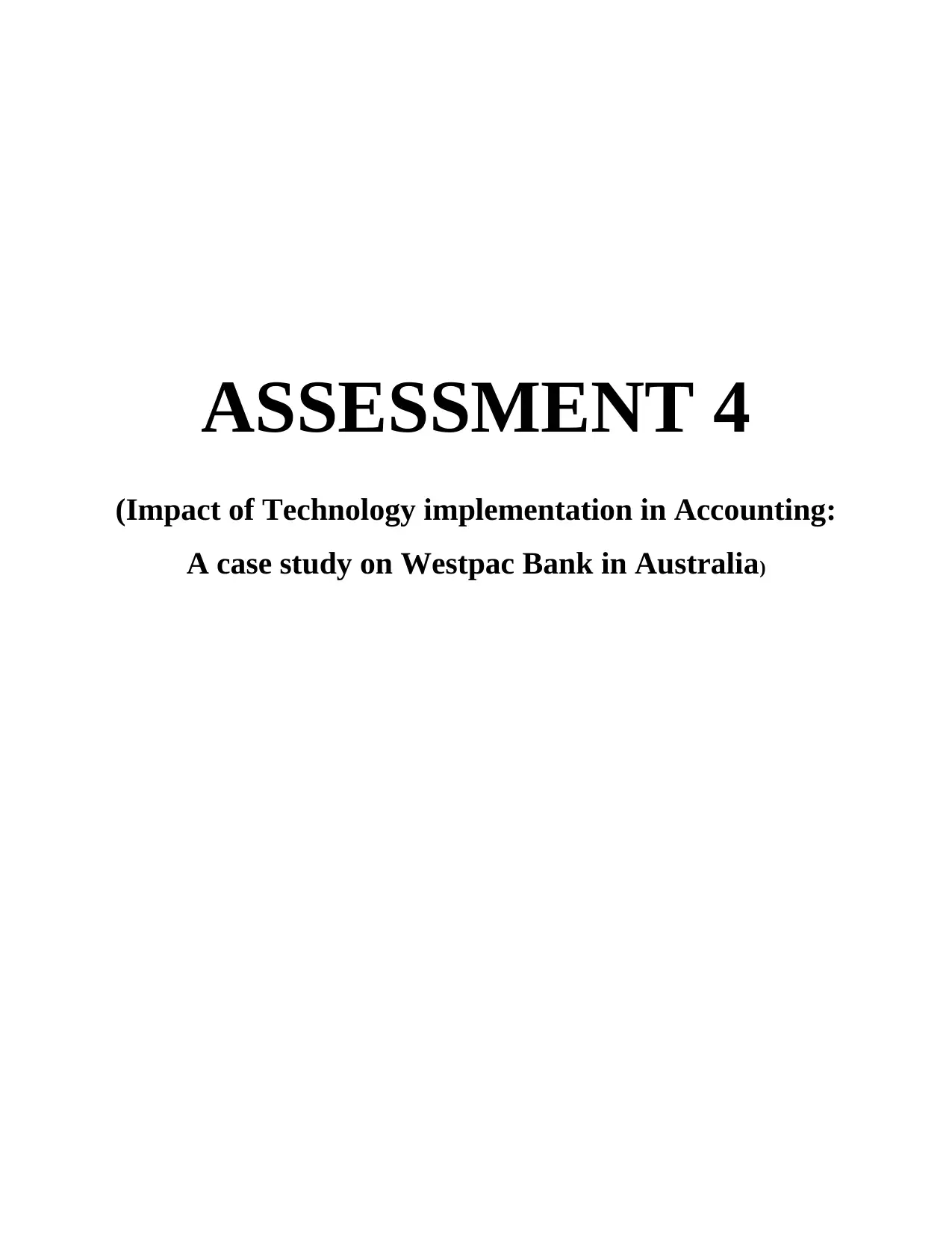
ASSESSMENT 4
(Impact of Technology implementation in Accounting:
A case study on Westpac Bank in Australia)
(Impact of Technology implementation in Accounting:
A case study on Westpac Bank in Australia)
Paraphrase This Document
Need a fresh take? Get an instant paraphrase of this document with our AI Paraphraser
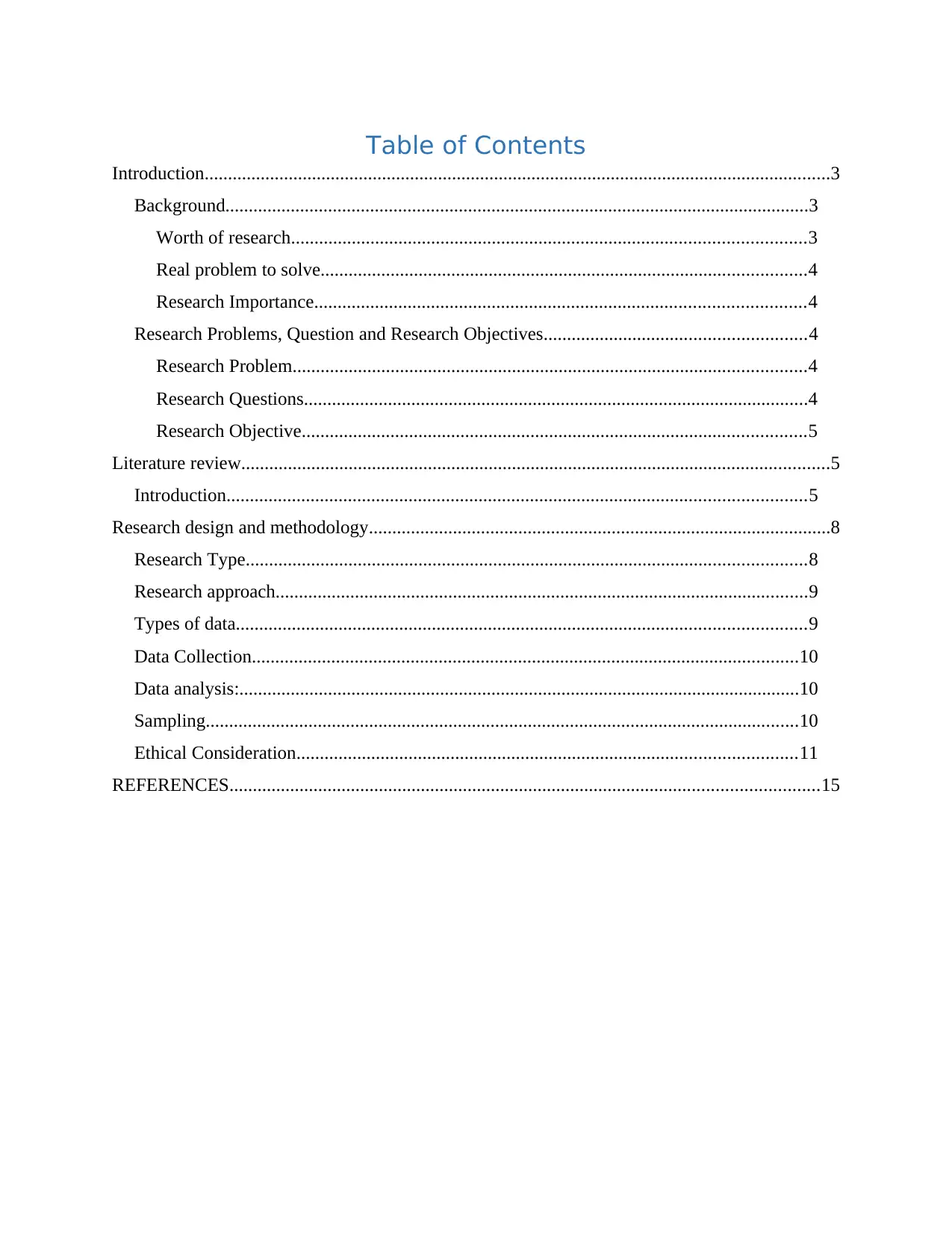
Table of Contents
Introduction......................................................................................................................................3
Background.............................................................................................................................3
Worth of research..............................................................................................................3
Real problem to solve........................................................................................................4
Research Importance.........................................................................................................4
Research Problems, Question and Research Objectives........................................................4
Research Problem..............................................................................................................4
Research Questions............................................................................................................4
Research Objective............................................................................................................5
Literature review..............................................................................................................................5
Introduction............................................................................................................................5
Research design and methodology...................................................................................................8
Research Type........................................................................................................................8
Research approach..................................................................................................................9
Types of data..........................................................................................................................9
Data Collection.....................................................................................................................10
Data analysis:........................................................................................................................10
Sampling...............................................................................................................................10
Ethical Consideration...........................................................................................................11
REFERENCES..............................................................................................................................15
Introduction......................................................................................................................................3
Background.............................................................................................................................3
Worth of research..............................................................................................................3
Real problem to solve........................................................................................................4
Research Importance.........................................................................................................4
Research Problems, Question and Research Objectives........................................................4
Research Problem..............................................................................................................4
Research Questions............................................................................................................4
Research Objective............................................................................................................5
Literature review..............................................................................................................................5
Introduction............................................................................................................................5
Research design and methodology...................................................................................................8
Research Type........................................................................................................................8
Research approach..................................................................................................................9
Types of data..........................................................................................................................9
Data Collection.....................................................................................................................10
Data analysis:........................................................................................................................10
Sampling...............................................................................................................................10
Ethical Consideration...........................................................................................................11
REFERENCES..............................................................................................................................15
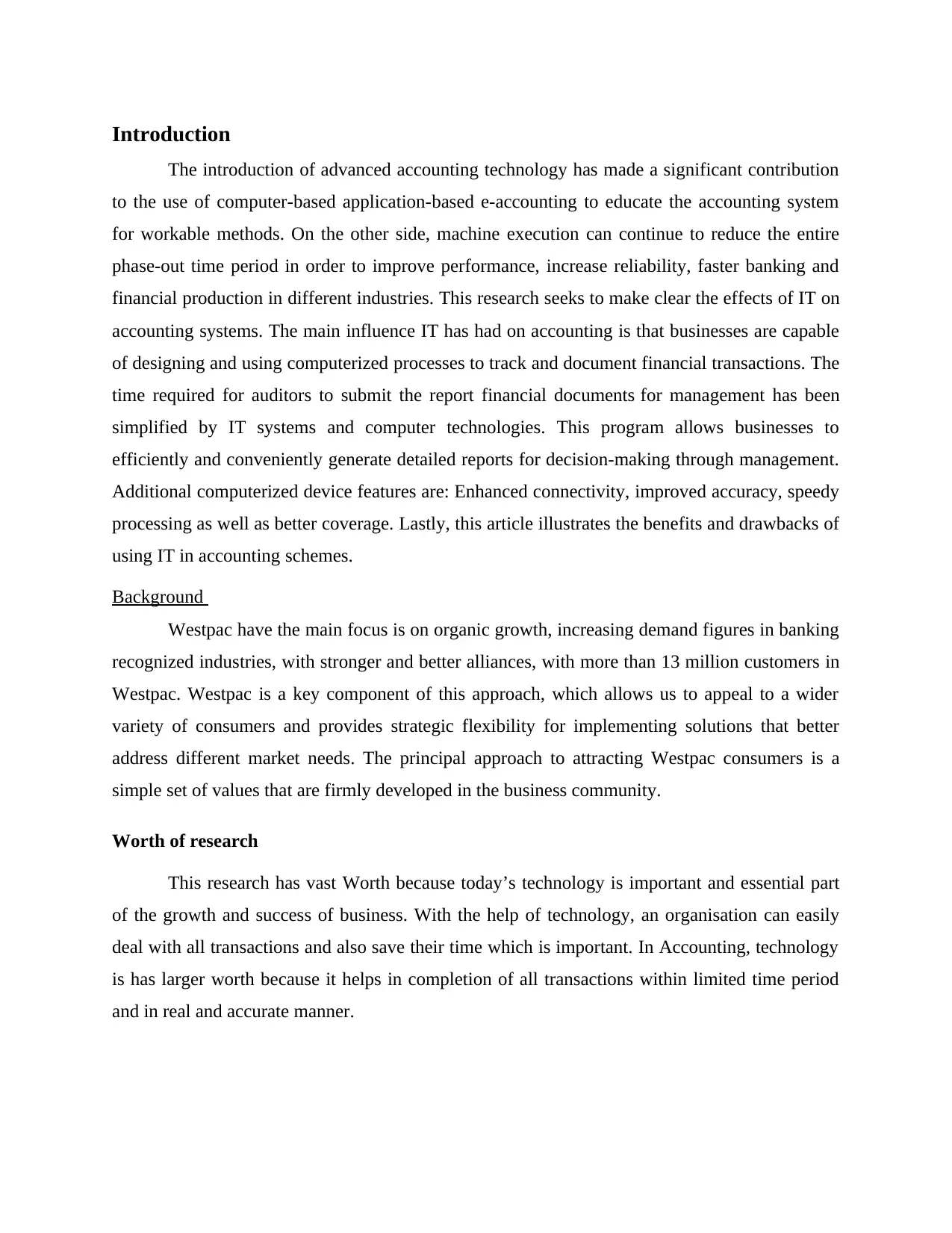
Introduction
The introduction of advanced accounting technology has made a significant contribution
to the use of computer-based application-based e-accounting to educate the accounting system
for workable methods. On the other side, machine execution can continue to reduce the entire
phase-out time period in order to improve performance, increase reliability, faster banking and
financial production in different industries. This research seeks to make clear the effects of IT on
accounting systems. The main influence IT has had on accounting is that businesses are capable
of designing and using computerized processes to track and document financial transactions. The
time required for auditors to submit the report financial documents for management has been
simplified by IT systems and computer technologies. This program allows businesses to
efficiently and conveniently generate detailed reports for decision-making through management.
Additional computerized device features are: Enhanced connectivity, improved accuracy, speedy
processing as well as better coverage. Lastly, this article illustrates the benefits and drawbacks of
using IT in accounting schemes.
Background
Westpac have the main focus is on organic growth, increasing demand figures in banking
recognized industries, with stronger and better alliances, with more than 13 million customers in
Westpac. Westpac is a key component of this approach, which allows us to appeal to a wider
variety of consumers and provides strategic flexibility for implementing solutions that better
address different market needs. The principal approach to attracting Westpac consumers is a
simple set of values that are firmly developed in the business community.
Worth of research
This research has vast Worth because today’s technology is important and essential part
of the growth and success of business. With the help of technology, an organisation can easily
deal with all transactions and also save their time which is important. In Accounting, technology
is has larger worth because it helps in completion of all transactions within limited time period
and in real and accurate manner.
The introduction of advanced accounting technology has made a significant contribution
to the use of computer-based application-based e-accounting to educate the accounting system
for workable methods. On the other side, machine execution can continue to reduce the entire
phase-out time period in order to improve performance, increase reliability, faster banking and
financial production in different industries. This research seeks to make clear the effects of IT on
accounting systems. The main influence IT has had on accounting is that businesses are capable
of designing and using computerized processes to track and document financial transactions. The
time required for auditors to submit the report financial documents for management has been
simplified by IT systems and computer technologies. This program allows businesses to
efficiently and conveniently generate detailed reports for decision-making through management.
Additional computerized device features are: Enhanced connectivity, improved accuracy, speedy
processing as well as better coverage. Lastly, this article illustrates the benefits and drawbacks of
using IT in accounting schemes.
Background
Westpac have the main focus is on organic growth, increasing demand figures in banking
recognized industries, with stronger and better alliances, with more than 13 million customers in
Westpac. Westpac is a key component of this approach, which allows us to appeal to a wider
variety of consumers and provides strategic flexibility for implementing solutions that better
address different market needs. The principal approach to attracting Westpac consumers is a
simple set of values that are firmly developed in the business community.
Worth of research
This research has vast Worth because today’s technology is important and essential part
of the growth and success of business. With the help of technology, an organisation can easily
deal with all transactions and also save their time which is important. In Accounting, technology
is has larger worth because it helps in completion of all transactions within limited time period
and in real and accurate manner.
⊘ This is a preview!⊘
Do you want full access?
Subscribe today to unlock all pages.

Trusted by 1+ million students worldwide
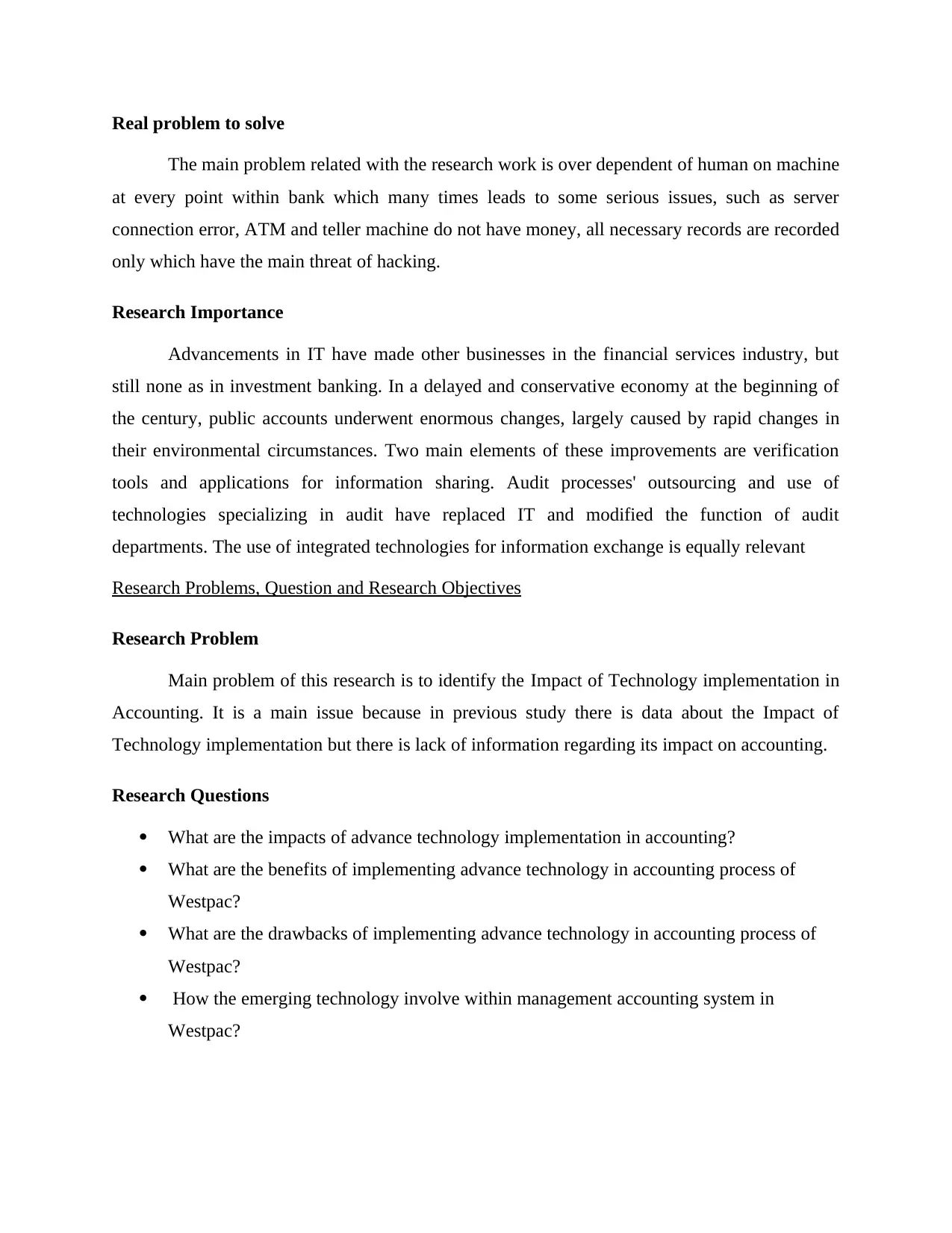
Real problem to solve
The main problem related with the research work is over dependent of human on machine
at every point within bank which many times leads to some serious issues, such as server
connection error, ATM and teller machine do not have money, all necessary records are recorded
only which have the main threat of hacking.
Research Importance
Advancements in IT have made other businesses in the financial services industry, but
still none as in investment banking. In a delayed and conservative economy at the beginning of
the century, public accounts underwent enormous changes, largely caused by rapid changes in
their environmental circumstances. Two main elements of these improvements are verification
tools and applications for information sharing. Audit processes' outsourcing and use of
technologies specializing in audit have replaced IT and modified the function of audit
departments. The use of integrated technologies for information exchange is equally relevant
Research Problems, Question and Research Objectives
Research Problem
Main problem of this research is to identify the Impact of Technology implementation in
Accounting. It is a main issue because in previous study there is data about the Impact of
Technology implementation but there is lack of information regarding its impact on accounting.
Research Questions
What are the impacts of advance technology implementation in accounting?
What are the benefits of implementing advance technology in accounting process of
Westpac?
What are the drawbacks of implementing advance technology in accounting process of
Westpac?
How the emerging technology involve within management accounting system in
Westpac?
The main problem related with the research work is over dependent of human on machine
at every point within bank which many times leads to some serious issues, such as server
connection error, ATM and teller machine do not have money, all necessary records are recorded
only which have the main threat of hacking.
Research Importance
Advancements in IT have made other businesses in the financial services industry, but
still none as in investment banking. In a delayed and conservative economy at the beginning of
the century, public accounts underwent enormous changes, largely caused by rapid changes in
their environmental circumstances. Two main elements of these improvements are verification
tools and applications for information sharing. Audit processes' outsourcing and use of
technologies specializing in audit have replaced IT and modified the function of audit
departments. The use of integrated technologies for information exchange is equally relevant
Research Problems, Question and Research Objectives
Research Problem
Main problem of this research is to identify the Impact of Technology implementation in
Accounting. It is a main issue because in previous study there is data about the Impact of
Technology implementation but there is lack of information regarding its impact on accounting.
Research Questions
What are the impacts of advance technology implementation in accounting?
What are the benefits of implementing advance technology in accounting process of
Westpac?
What are the drawbacks of implementing advance technology in accounting process of
Westpac?
How the emerging technology involve within management accounting system in
Westpac?
Paraphrase This Document
Need a fresh take? Get an instant paraphrase of this document with our AI Paraphraser
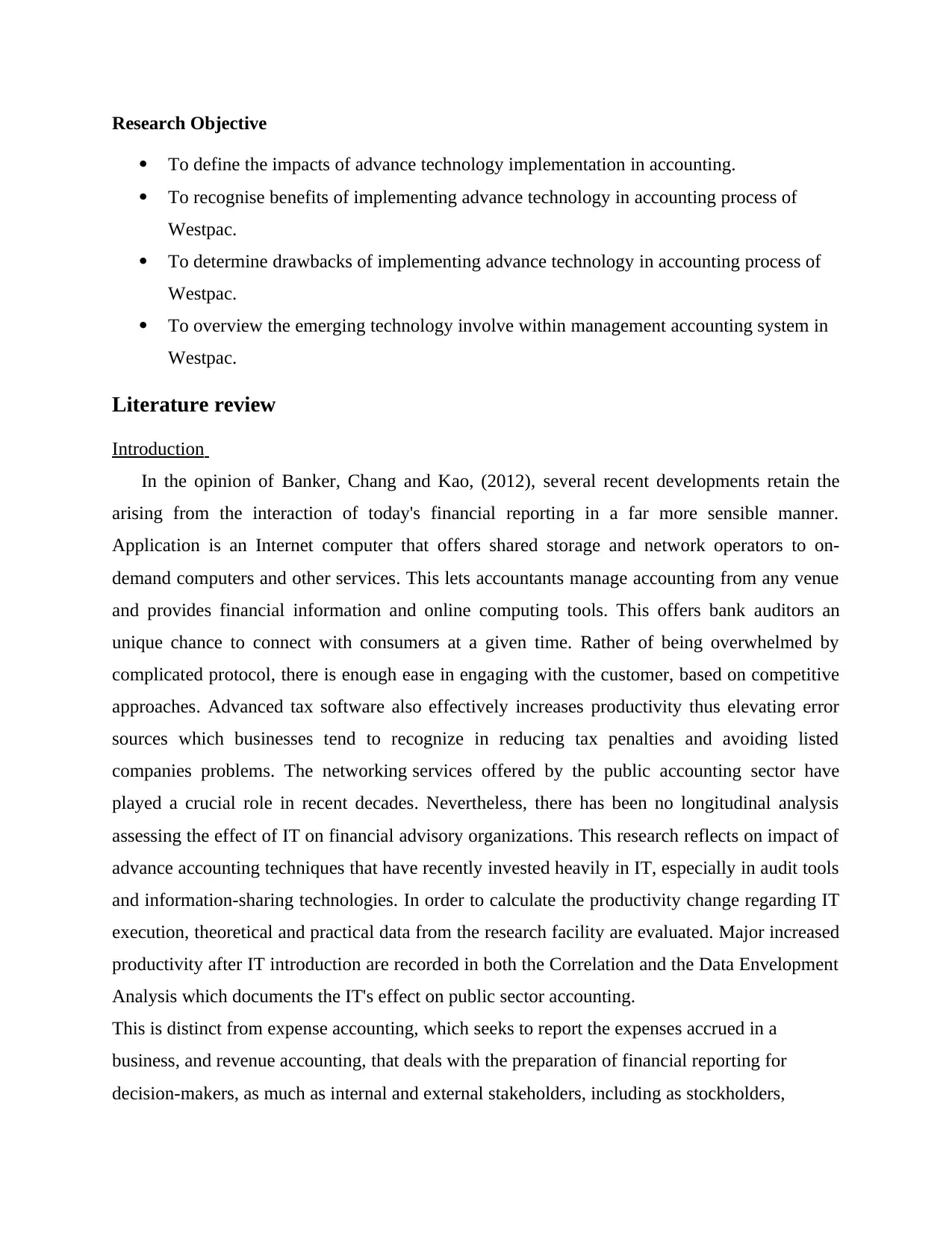
Research Objective
To define the impacts of advance technology implementation in accounting.
To recognise benefits of implementing advance technology in accounting process of
Westpac.
To determine drawbacks of implementing advance technology in accounting process of
Westpac.
To overview the emerging technology involve within management accounting system in
Westpac.
Literature review
Introduction
In the opinion of Banker, Chang and Kao, (2012), several recent developments retain the
arising from the interaction of today's financial reporting in a far more sensible manner.
Application is an Internet computer that offers shared storage and network operators to on-
demand computers and other services. This lets accountants manage accounting from any venue
and provides financial information and online computing tools. This offers bank auditors an
unique chance to connect with consumers at a given time. Rather of being overwhelmed by
complicated protocol, there is enough ease in engaging with the customer, based on competitive
approaches. Advanced tax software also effectively increases productivity thus elevating error
sources which businesses tend to recognize in reducing tax penalties and avoiding listed
companies problems. The networking services offered by the public accounting sector have
played a crucial role in recent decades. Nevertheless, there has been no longitudinal analysis
assessing the effect of IT on financial advisory organizations. This research reflects on impact of
advance accounting techniques that have recently invested heavily in IT, especially in audit tools
and information-sharing technologies. In order to calculate the productivity change regarding IT
execution, theoretical and practical data from the research facility are evaluated. Major increased
productivity after IT introduction are recorded in both the Correlation and the Data Envelopment
Analysis which documents the IT's effect on public sector accounting.
This is distinct from expense accounting, which seeks to report the expenses accrued in a
business, and revenue accounting, that deals with the preparation of financial reporting for
decision-makers, as much as internal and external stakeholders, including as stockholders,
To define the impacts of advance technology implementation in accounting.
To recognise benefits of implementing advance technology in accounting process of
Westpac.
To determine drawbacks of implementing advance technology in accounting process of
Westpac.
To overview the emerging technology involve within management accounting system in
Westpac.
Literature review
Introduction
In the opinion of Banker, Chang and Kao, (2012), several recent developments retain the
arising from the interaction of today's financial reporting in a far more sensible manner.
Application is an Internet computer that offers shared storage and network operators to on-
demand computers and other services. This lets accountants manage accounting from any venue
and provides financial information and online computing tools. This offers bank auditors an
unique chance to connect with consumers at a given time. Rather of being overwhelmed by
complicated protocol, there is enough ease in engaging with the customer, based on competitive
approaches. Advanced tax software also effectively increases productivity thus elevating error
sources which businesses tend to recognize in reducing tax penalties and avoiding listed
companies problems. The networking services offered by the public accounting sector have
played a crucial role in recent decades. Nevertheless, there has been no longitudinal analysis
assessing the effect of IT on financial advisory organizations. This research reflects on impact of
advance accounting techniques that have recently invested heavily in IT, especially in audit tools
and information-sharing technologies. In order to calculate the productivity change regarding IT
execution, theoretical and practical data from the research facility are evaluated. Major increased
productivity after IT introduction are recorded in both the Correlation and the Data Envelopment
Analysis which documents the IT's effect on public sector accounting.
This is distinct from expense accounting, which seeks to report the expenses accrued in a
business, and revenue accounting, that deals with the preparation of financial reporting for
decision-makers, as much as internal and external stakeholders, including as stockholders,
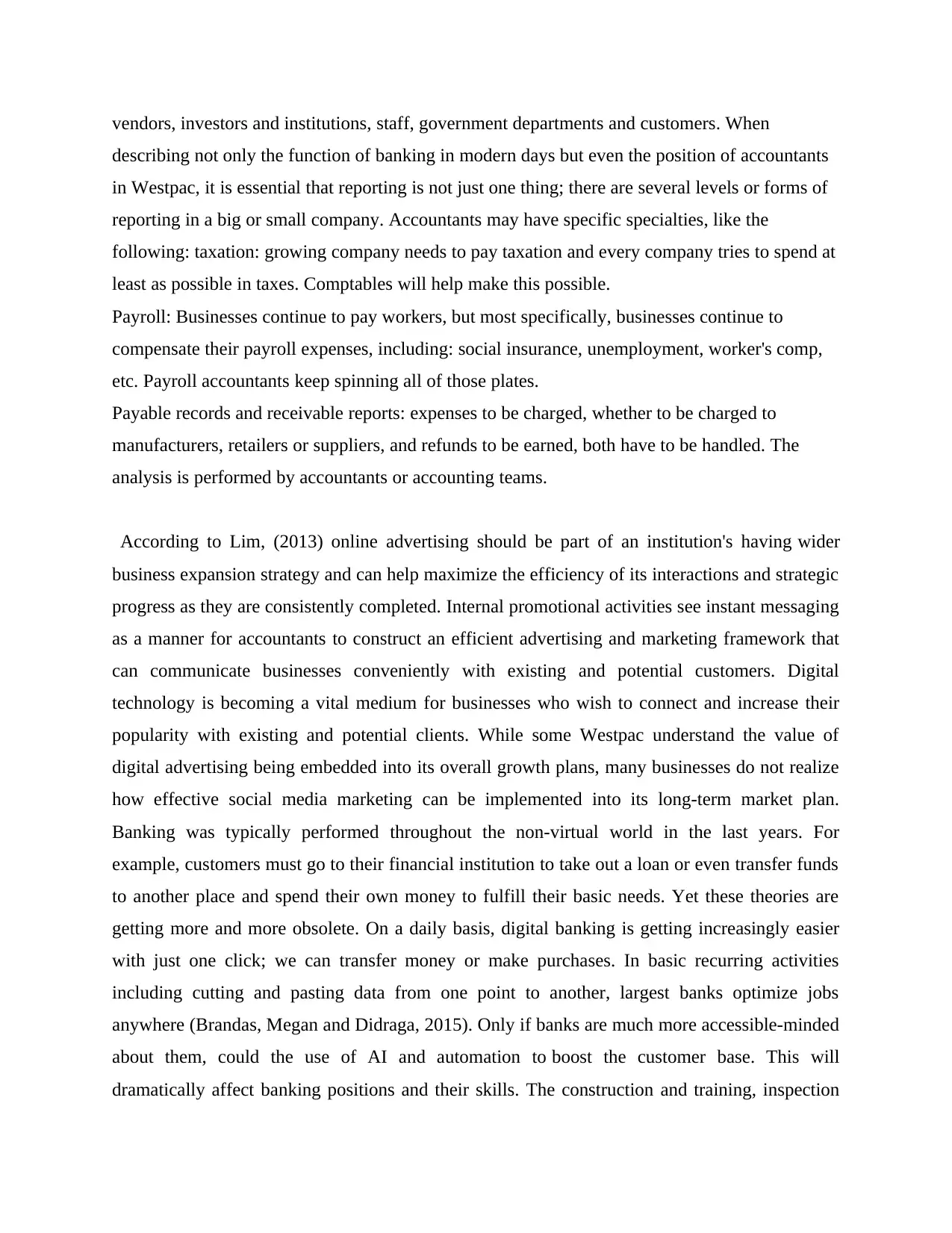
vendors, investors and institutions, staff, government departments and customers. When
describing not only the function of banking in modern days but even the position of accountants
in Westpac, it is essential that reporting is not just one thing; there are several levels or forms of
reporting in a big or small company. Accountants may have specific specialties, like the
following: taxation: growing company needs to pay taxation and every company tries to spend at
least as possible in taxes. Comptables will help make this possible.
Payroll: Businesses continue to pay workers, but most specifically, businesses continue to
compensate their payroll expenses, including: social insurance, unemployment, worker's comp,
etc. Payroll accountants keep spinning all of those plates.
Payable records and receivable reports: expenses to be charged, whether to be charged to
manufacturers, retailers or suppliers, and refunds to be earned, both have to be handled. The
analysis is performed by accountants or accounting teams.
According to Lim, (2013) online advertising should be part of an institution's having wider
business expansion strategy and can help maximize the efficiency of its interactions and strategic
progress as they are consistently completed. Internal promotional activities see instant messaging
as a manner for accountants to construct an efficient advertising and marketing framework that
can communicate businesses conveniently with existing and potential customers. Digital
technology is becoming a vital medium for businesses who wish to connect and increase their
popularity with existing and potential clients. While some Westpac understand the value of
digital advertising being embedded into its overall growth plans, many businesses do not realize
how effective social media marketing can be implemented into its long-term market plan.
Banking was typically performed throughout the non-virtual world in the last years. For
example, customers must go to their financial institution to take out a loan or even transfer funds
to another place and spend their own money to fulfill their basic needs. Yet these theories are
getting more and more obsolete. On a daily basis, digital banking is getting increasingly easier
with just one click; we can transfer money or make purchases. In basic recurring activities
including cutting and pasting data from one point to another, largest banks optimize jobs
anywhere (Brandas, Megan and Didraga, 2015). Only if banks are much more accessible-minded
about them, could the use of AI and automation to boost the customer base. This will
dramatically affect banking positions and their skills. The construction and training, inspection
describing not only the function of banking in modern days but even the position of accountants
in Westpac, it is essential that reporting is not just one thing; there are several levels or forms of
reporting in a big or small company. Accountants may have specific specialties, like the
following: taxation: growing company needs to pay taxation and every company tries to spend at
least as possible in taxes. Comptables will help make this possible.
Payroll: Businesses continue to pay workers, but most specifically, businesses continue to
compensate their payroll expenses, including: social insurance, unemployment, worker's comp,
etc. Payroll accountants keep spinning all of those plates.
Payable records and receivable reports: expenses to be charged, whether to be charged to
manufacturers, retailers or suppliers, and refunds to be earned, both have to be handled. The
analysis is performed by accountants or accounting teams.
According to Lim, (2013) online advertising should be part of an institution's having wider
business expansion strategy and can help maximize the efficiency of its interactions and strategic
progress as they are consistently completed. Internal promotional activities see instant messaging
as a manner for accountants to construct an efficient advertising and marketing framework that
can communicate businesses conveniently with existing and potential customers. Digital
technology is becoming a vital medium for businesses who wish to connect and increase their
popularity with existing and potential clients. While some Westpac understand the value of
digital advertising being embedded into its overall growth plans, many businesses do not realize
how effective social media marketing can be implemented into its long-term market plan.
Banking was typically performed throughout the non-virtual world in the last years. For
example, customers must go to their financial institution to take out a loan or even transfer funds
to another place and spend their own money to fulfill their basic needs. Yet these theories are
getting more and more obsolete. On a daily basis, digital banking is getting increasingly easier
with just one click; we can transfer money or make purchases. In basic recurring activities
including cutting and pasting data from one point to another, largest banks optimize jobs
anywhere (Brandas, Megan and Didraga, 2015). Only if banks are much more accessible-minded
about them, could the use of AI and automation to boost the customer base. This will
dramatically affect banking positions and their skills. The construction and training, inspection
⊘ This is a preview!⊘
Do you want full access?
Subscribe today to unlock all pages.

Trusted by 1+ million students worldwide
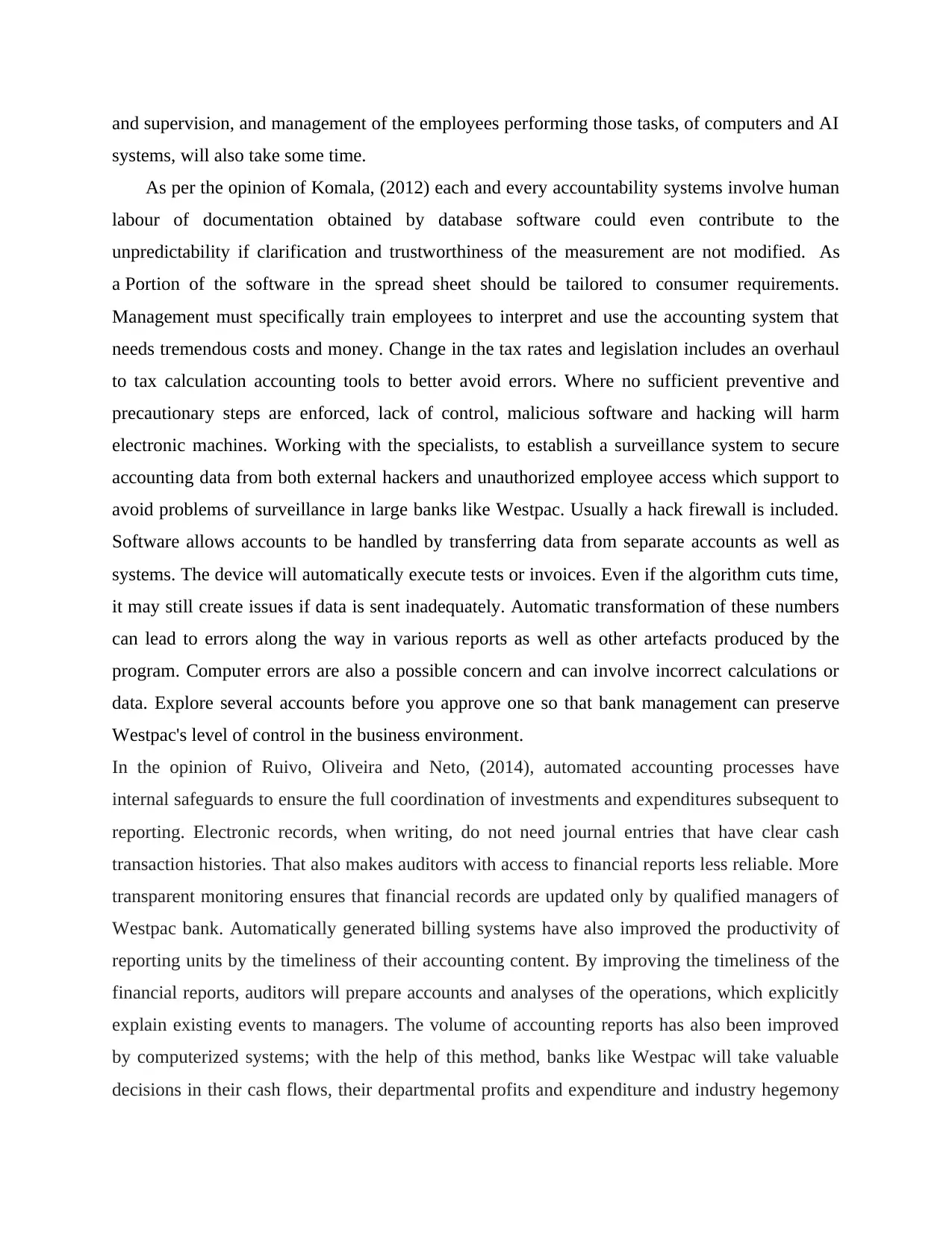
and supervision, and management of the employees performing those tasks, of computers and AI
systems, will also take some time.
As per the opinion of Komala, (2012) each and every accountability systems involve human
labour of documentation obtained by database software could even contribute to the
unpredictability if clarification and trustworthiness of the measurement are not modified. As
a Portion of the software in the spread sheet should be tailored to consumer requirements.
Management must specifically train employees to interpret and use the accounting system that
needs tremendous costs and money. Change in the tax rates and legislation includes an overhaul
to tax calculation accounting tools to better avoid errors. Where no sufficient preventive and
precautionary steps are enforced, lack of control, malicious software and hacking will harm
electronic machines. Working with the specialists, to establish a surveillance system to secure
accounting data from both external hackers and unauthorized employee access which support to
avoid problems of surveillance in large banks like Westpac. Usually a hack firewall is included.
Software allows accounts to be handled by transferring data from separate accounts as well as
systems. The device will automatically execute tests or invoices. Even if the algorithm cuts time,
it may still create issues if data is sent inadequately. Automatic transformation of these numbers
can lead to errors along the way in various reports as well as other artefacts produced by the
program. Computer errors are also a possible concern and can involve incorrect calculations or
data. Explore several accounts before you approve one so that bank management can preserve
Westpac's level of control in the business environment.
In the opinion of Ruivo, Oliveira and Neto, (2014), automated accounting processes have
internal safeguards to ensure the full coordination of investments and expenditures subsequent to
reporting. Electronic records, when writing, do not need journal entries that have clear cash
transaction histories. That also makes auditors with access to financial reports less reliable. More
transparent monitoring ensures that financial records are updated only by qualified managers of
Westpac bank. Automatically generated billing systems have also improved the productivity of
reporting units by the timeliness of their accounting content. By improving the timeliness of the
financial reports, auditors will prepare accounts and analyses of the operations, which explicitly
explain existing events to managers. The volume of accounting reports has also been improved
by computerized systems; with the help of this method, banks like Westpac will take valuable
decisions in their cash flows, their departmental profits and expenditure and industry hegemony
systems, will also take some time.
As per the opinion of Komala, (2012) each and every accountability systems involve human
labour of documentation obtained by database software could even contribute to the
unpredictability if clarification and trustworthiness of the measurement are not modified. As
a Portion of the software in the spread sheet should be tailored to consumer requirements.
Management must specifically train employees to interpret and use the accounting system that
needs tremendous costs and money. Change in the tax rates and legislation includes an overhaul
to tax calculation accounting tools to better avoid errors. Where no sufficient preventive and
precautionary steps are enforced, lack of control, malicious software and hacking will harm
electronic machines. Working with the specialists, to establish a surveillance system to secure
accounting data from both external hackers and unauthorized employee access which support to
avoid problems of surveillance in large banks like Westpac. Usually a hack firewall is included.
Software allows accounts to be handled by transferring data from separate accounts as well as
systems. The device will automatically execute tests or invoices. Even if the algorithm cuts time,
it may still create issues if data is sent inadequately. Automatic transformation of these numbers
can lead to errors along the way in various reports as well as other artefacts produced by the
program. Computer errors are also a possible concern and can involve incorrect calculations or
data. Explore several accounts before you approve one so that bank management can preserve
Westpac's level of control in the business environment.
In the opinion of Ruivo, Oliveira and Neto, (2014), automated accounting processes have
internal safeguards to ensure the full coordination of investments and expenditures subsequent to
reporting. Electronic records, when writing, do not need journal entries that have clear cash
transaction histories. That also makes auditors with access to financial reports less reliable. More
transparent monitoring ensures that financial records are updated only by qualified managers of
Westpac bank. Automatically generated billing systems have also improved the productivity of
reporting units by the timeliness of their accounting content. By improving the timeliness of the
financial reports, auditors will prepare accounts and analyses of the operations, which explicitly
explain existing events to managers. The volume of accounting reports has also been improved
by computerized systems; with the help of this method, banks like Westpac will take valuable
decisions in their cash flows, their departmental profits and expenditure and industry hegemony
Paraphrase This Document
Need a fresh take? Get an instant paraphrase of this document with our AI Paraphraser
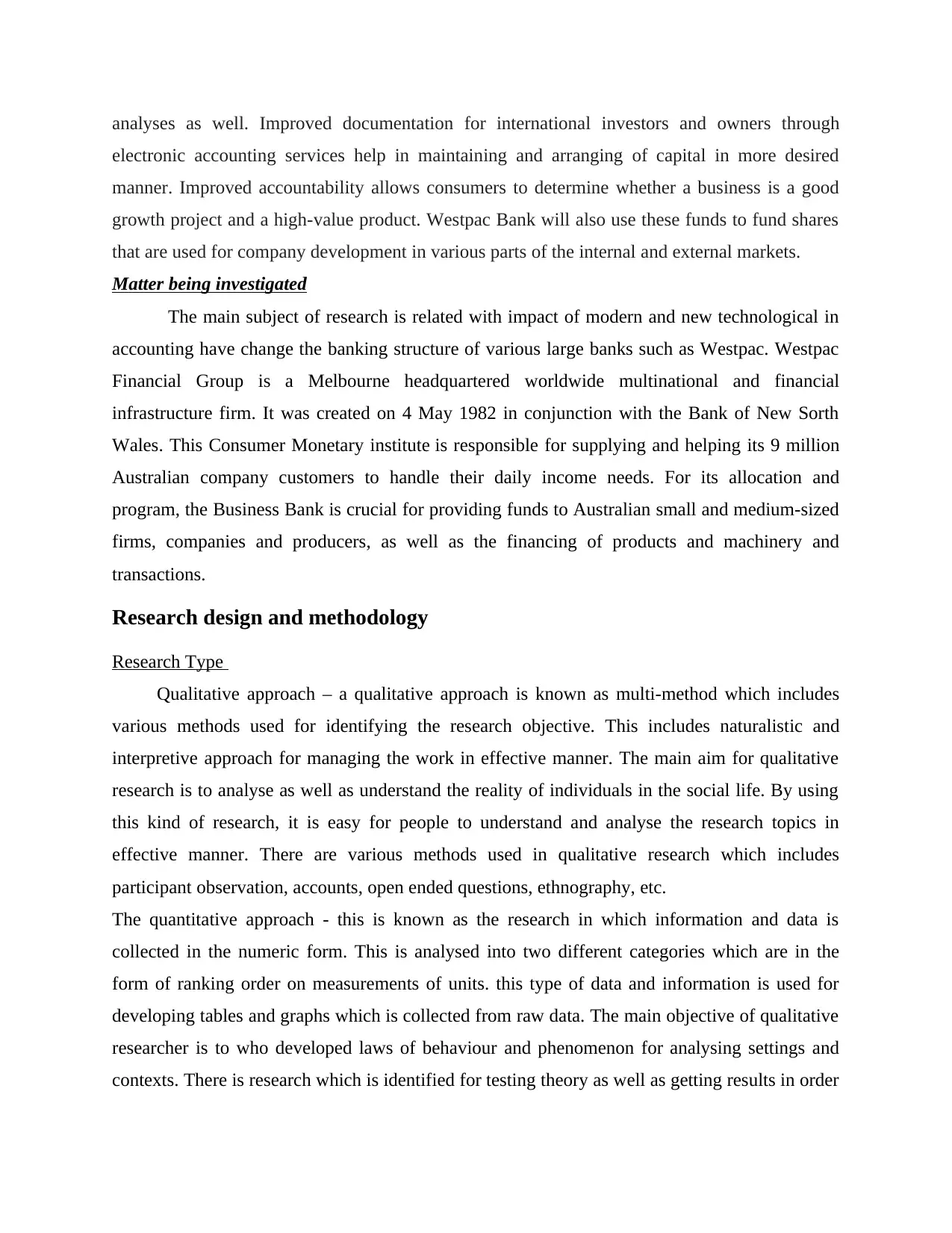
analyses as well. Improved documentation for international investors and owners through
electronic accounting services help in maintaining and arranging of capital in more desired
manner. Improved accountability allows consumers to determine whether a business is a good
growth project and a high-value product. Westpac Bank will also use these funds to fund shares
that are used for company development in various parts of the internal and external markets.
Matter being investigated
The main subject of research is related with impact of modern and new technological in
accounting have change the banking structure of various large banks such as Westpac. Westpac
Financial Group is a Melbourne headquartered worldwide multinational and financial
infrastructure firm. It was created on 4 May 1982 in conjunction with the Bank of New Sorth
Wales. This Consumer Monetary institute is responsible for supplying and helping its 9 million
Australian company customers to handle their daily income needs. For its allocation and
program, the Business Bank is crucial for providing funds to Australian small and medium-sized
firms, companies and producers, as well as the financing of products and machinery and
transactions.
Research design and methodology
Research Type
Qualitative approach – a qualitative approach is known as multi-method which includes
various methods used for identifying the research objective. This includes naturalistic and
interpretive approach for managing the work in effective manner. The main aim for qualitative
research is to analyse as well as understand the reality of individuals in the social life. By using
this kind of research, it is easy for people to understand and analyse the research topics in
effective manner. There are various methods used in qualitative research which includes
participant observation, accounts, open ended questions, ethnography, etc.
The quantitative approach - this is known as the research in which information and data is
collected in the numeric form. This is analysed into two different categories which are in the
form of ranking order on measurements of units. this type of data and information is used for
developing tables and graphs which is collected from raw data. The main objective of qualitative
researcher is to who developed laws of behaviour and phenomenon for analysing settings and
contexts. There is research which is identified for testing theory as well as getting results in order
electronic accounting services help in maintaining and arranging of capital in more desired
manner. Improved accountability allows consumers to determine whether a business is a good
growth project and a high-value product. Westpac Bank will also use these funds to fund shares
that are used for company development in various parts of the internal and external markets.
Matter being investigated
The main subject of research is related with impact of modern and new technological in
accounting have change the banking structure of various large banks such as Westpac. Westpac
Financial Group is a Melbourne headquartered worldwide multinational and financial
infrastructure firm. It was created on 4 May 1982 in conjunction with the Bank of New Sorth
Wales. This Consumer Monetary institute is responsible for supplying and helping its 9 million
Australian company customers to handle their daily income needs. For its allocation and
program, the Business Bank is crucial for providing funds to Australian small and medium-sized
firms, companies and producers, as well as the financing of products and machinery and
transactions.
Research design and methodology
Research Type
Qualitative approach – a qualitative approach is known as multi-method which includes
various methods used for identifying the research objective. This includes naturalistic and
interpretive approach for managing the work in effective manner. The main aim for qualitative
research is to analyse as well as understand the reality of individuals in the social life. By using
this kind of research, it is easy for people to understand and analyse the research topics in
effective manner. There are various methods used in qualitative research which includes
participant observation, accounts, open ended questions, ethnography, etc.
The quantitative approach - this is known as the research in which information and data is
collected in the numeric form. This is analysed into two different categories which are in the
form of ranking order on measurements of units. this type of data and information is used for
developing tables and graphs which is collected from raw data. The main objective of qualitative
researcher is to who developed laws of behaviour and phenomenon for analysing settings and
contexts. There is research which is identified for testing theory as well as getting results in order
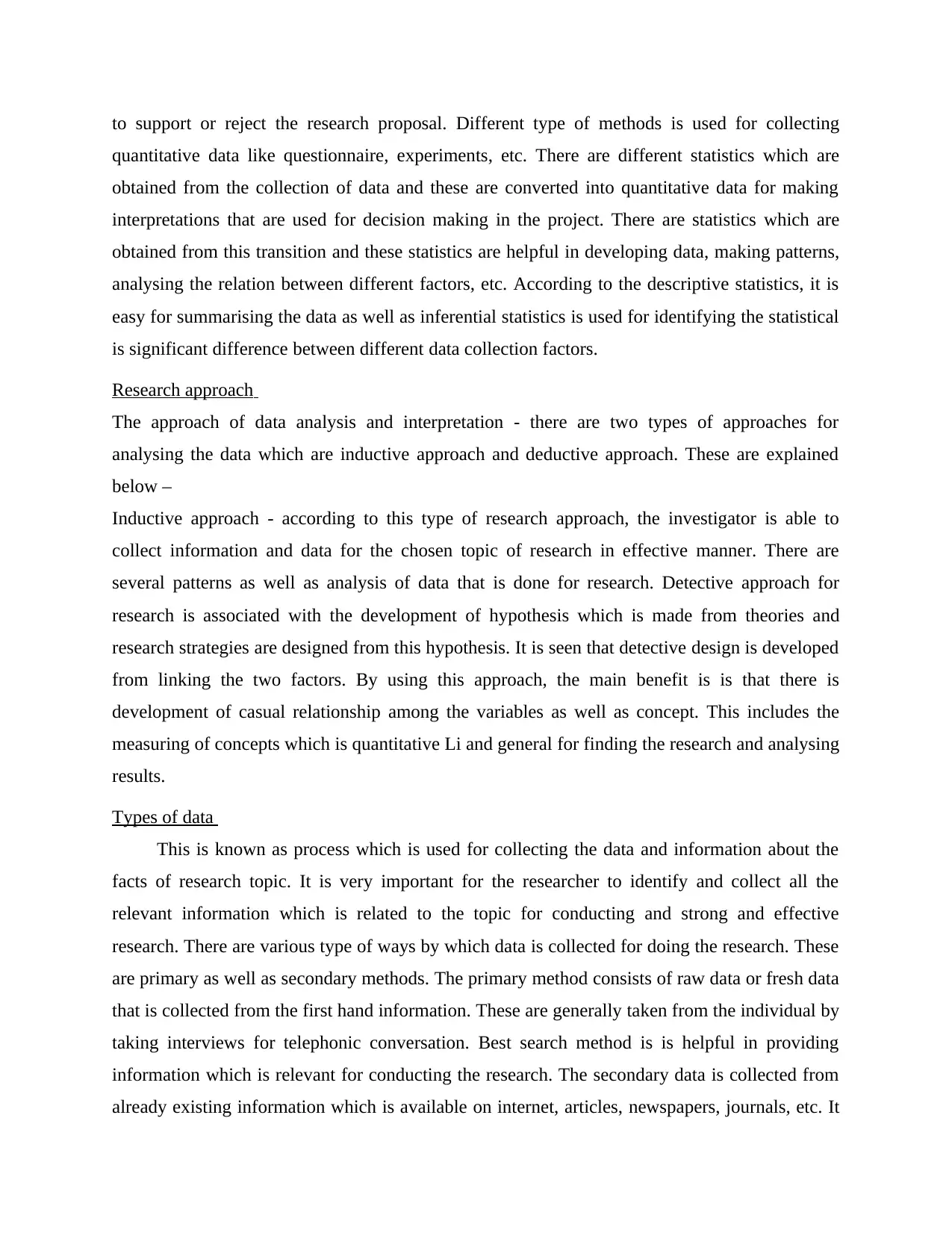
to support or reject the research proposal. Different type of methods is used for collecting
quantitative data like questionnaire, experiments, etc. There are different statistics which are
obtained from the collection of data and these are converted into quantitative data for making
interpretations that are used for decision making in the project. There are statistics which are
obtained from this transition and these statistics are helpful in developing data, making patterns,
analysing the relation between different factors, etc. According to the descriptive statistics, it is
easy for summarising the data as well as inferential statistics is used for identifying the statistical
is significant difference between different data collection factors.
Research approach
The approach of data analysis and interpretation - there are two types of approaches for
analysing the data which are inductive approach and deductive approach. These are explained
below –
Inductive approach - according to this type of research approach, the investigator is able to
collect information and data for the chosen topic of research in effective manner. There are
several patterns as well as analysis of data that is done for research. Detective approach for
research is associated with the development of hypothesis which is made from theories and
research strategies are designed from this hypothesis. It is seen that detective design is developed
from linking the two factors. By using this approach, the main benefit is is that there is
development of casual relationship among the variables as well as concept. This includes the
measuring of concepts which is quantitative Li and general for finding the research and analysing
results.
Types of data
This is known as process which is used for collecting the data and information about the
facts of research topic. It is very important for the researcher to identify and collect all the
relevant information which is related to the topic for conducting and strong and effective
research. There are various type of ways by which data is collected for doing the research. These
are primary as well as secondary methods. The primary method consists of raw data or fresh data
that is collected from the first hand information. These are generally taken from the individual by
taking interviews for telephonic conversation. Best search method is is helpful in providing
information which is relevant for conducting the research. The secondary data is collected from
already existing information which is available on internet, articles, newspapers, journals, etc. It
quantitative data like questionnaire, experiments, etc. There are different statistics which are
obtained from the collection of data and these are converted into quantitative data for making
interpretations that are used for decision making in the project. There are statistics which are
obtained from this transition and these statistics are helpful in developing data, making patterns,
analysing the relation between different factors, etc. According to the descriptive statistics, it is
easy for summarising the data as well as inferential statistics is used for identifying the statistical
is significant difference between different data collection factors.
Research approach
The approach of data analysis and interpretation - there are two types of approaches for
analysing the data which are inductive approach and deductive approach. These are explained
below –
Inductive approach - according to this type of research approach, the investigator is able to
collect information and data for the chosen topic of research in effective manner. There are
several patterns as well as analysis of data that is done for research. Detective approach for
research is associated with the development of hypothesis which is made from theories and
research strategies are designed from this hypothesis. It is seen that detective design is developed
from linking the two factors. By using this approach, the main benefit is is that there is
development of casual relationship among the variables as well as concept. This includes the
measuring of concepts which is quantitative Li and general for finding the research and analysing
results.
Types of data
This is known as process which is used for collecting the data and information about the
facts of research topic. It is very important for the researcher to identify and collect all the
relevant information which is related to the topic for conducting and strong and effective
research. There are various type of ways by which data is collected for doing the research. These
are primary as well as secondary methods. The primary method consists of raw data or fresh data
that is collected from the first hand information. These are generally taken from the individual by
taking interviews for telephonic conversation. Best search method is is helpful in providing
information which is relevant for conducting the research. The secondary data is collected from
already existing information which is available on internet, articles, newspapers, journals, etc. It
⊘ This is a preview!⊘
Do you want full access?
Subscribe today to unlock all pages.

Trusted by 1+ million students worldwide
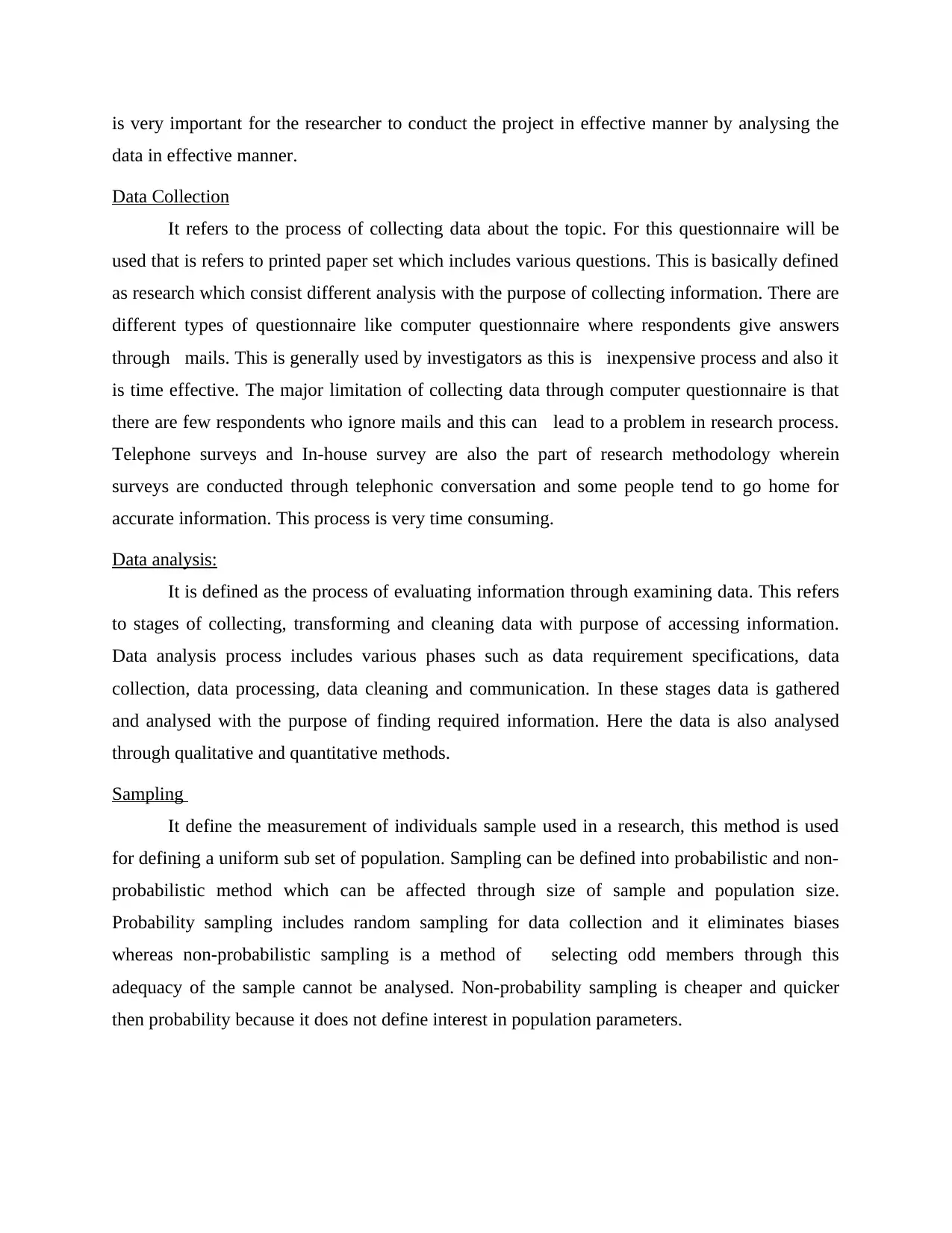
is very important for the researcher to conduct the project in effective manner by analysing the
data in effective manner.
Data Collection
It refers to the process of collecting data about the topic. For this questionnaire will be
used that is refers to printed paper set which includes various questions. This is basically defined
as research which consist different analysis with the purpose of collecting information. There are
different types of questionnaire like computer questionnaire where respondents give answers
through mails. This is generally used by investigators as this is inexpensive process and also it
is time effective. The major limitation of collecting data through computer questionnaire is that
there are few respondents who ignore mails and this can lead to a problem in research process.
Telephone surveys and In-house survey are also the part of research methodology wherein
surveys are conducted through telephonic conversation and some people tend to go home for
accurate information. This process is very time consuming.
Data analysis:
It is defined as the process of evaluating information through examining data. This refers
to stages of collecting, transforming and cleaning data with purpose of accessing information.
Data analysis process includes various phases such as data requirement specifications, data
collection, data processing, data cleaning and communication. In these stages data is gathered
and analysed with the purpose of finding required information. Here the data is also analysed
through qualitative and quantitative methods.
Sampling
It define the measurement of individuals sample used in a research, this method is used
for defining a uniform sub set of population. Sampling can be defined into probabilistic and non-
probabilistic method which can be affected through size of sample and population size.
Probability sampling includes random sampling for data collection and it eliminates biases
whereas non-probabilistic sampling is a method of selecting odd members through this
adequacy of the sample cannot be analysed. Non-probability sampling is cheaper and quicker
then probability because it does not define interest in population parameters.
data in effective manner.
Data Collection
It refers to the process of collecting data about the topic. For this questionnaire will be
used that is refers to printed paper set which includes various questions. This is basically defined
as research which consist different analysis with the purpose of collecting information. There are
different types of questionnaire like computer questionnaire where respondents give answers
through mails. This is generally used by investigators as this is inexpensive process and also it
is time effective. The major limitation of collecting data through computer questionnaire is that
there are few respondents who ignore mails and this can lead to a problem in research process.
Telephone surveys and In-house survey are also the part of research methodology wherein
surveys are conducted through telephonic conversation and some people tend to go home for
accurate information. This process is very time consuming.
Data analysis:
It is defined as the process of evaluating information through examining data. This refers
to stages of collecting, transforming and cleaning data with purpose of accessing information.
Data analysis process includes various phases such as data requirement specifications, data
collection, data processing, data cleaning and communication. In these stages data is gathered
and analysed with the purpose of finding required information. Here the data is also analysed
through qualitative and quantitative methods.
Sampling
It define the measurement of individuals sample used in a research, this method is used
for defining a uniform sub set of population. Sampling can be defined into probabilistic and non-
probabilistic method which can be affected through size of sample and population size.
Probability sampling includes random sampling for data collection and it eliminates biases
whereas non-probabilistic sampling is a method of selecting odd members through this
adequacy of the sample cannot be analysed. Non-probability sampling is cheaper and quicker
then probability because it does not define interest in population parameters.
Paraphrase This Document
Need a fresh take? Get an instant paraphrase of this document with our AI Paraphraser
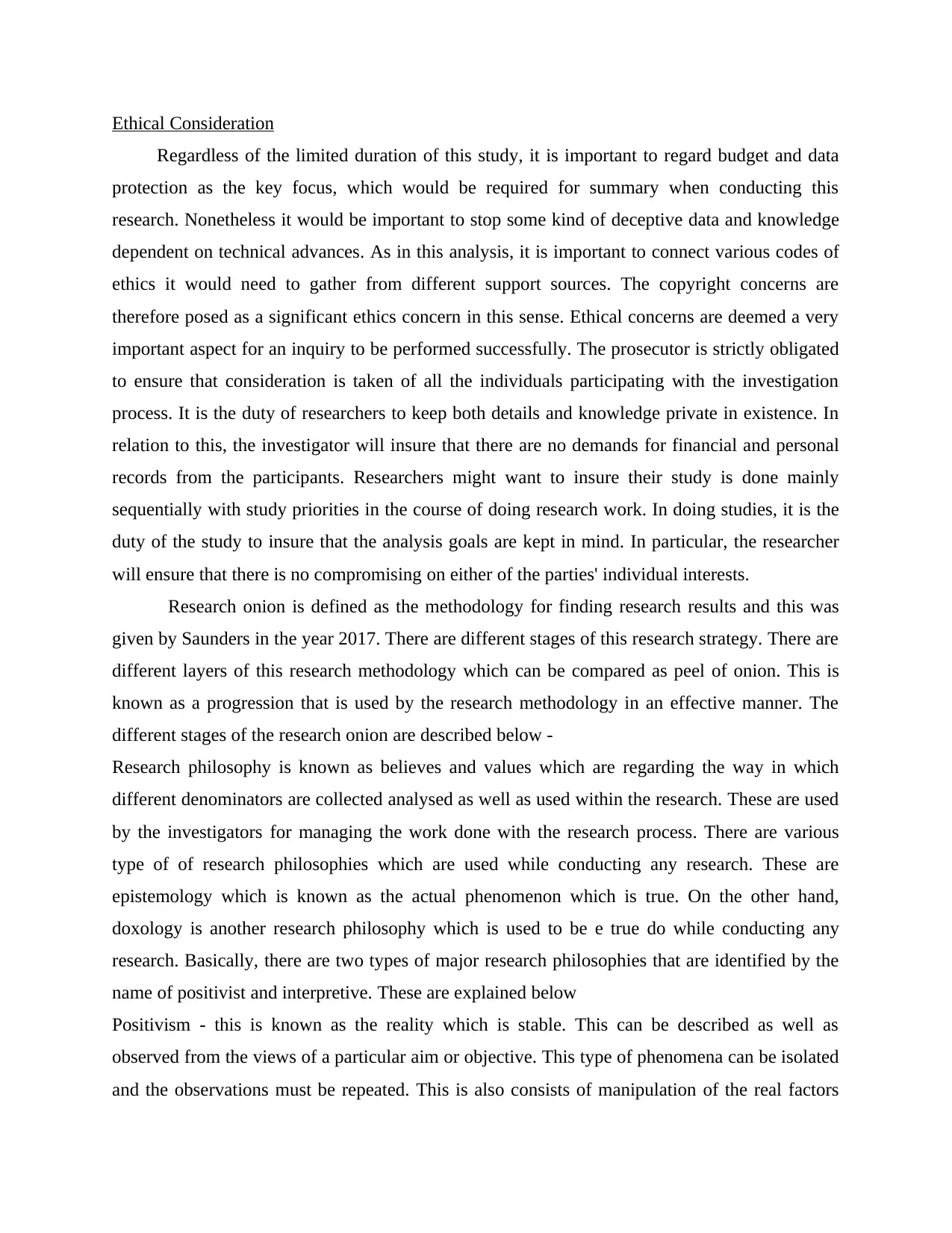
Ethical Consideration
Regardless of the limited duration of this study, it is important to regard budget and data
protection as the key focus, which would be required for summary when conducting this
research. Nonetheless it would be important to stop some kind of deceptive data and knowledge
dependent on technical advances. As in this analysis, it is important to connect various codes of
ethics it would need to gather from different support sources. The copyright concerns are
therefore posed as a significant ethics concern in this sense. Ethical concerns are deemed a very
important aspect for an inquiry to be performed successfully. The prosecutor is strictly obligated
to ensure that consideration is taken of all the individuals participating with the investigation
process. It is the duty of researchers to keep both details and knowledge private in existence. In
relation to this, the investigator will insure that there are no demands for financial and personal
records from the participants. Researchers might want to insure their study is done mainly
sequentially with study priorities in the course of doing research work. In doing studies, it is the
duty of the study to insure that the analysis goals are kept in mind. In particular, the researcher
will ensure that there is no compromising on either of the parties' individual interests.
Research onion is defined as the methodology for finding research results and this was
given by Saunders in the year 2017. There are different stages of this research strategy. There are
different layers of this research methodology which can be compared as peel of onion. This is
known as a progression that is used by the research methodology in an effective manner. The
different stages of the research onion are described below -
Research philosophy is known as believes and values which are regarding the way in which
different denominators are collected analysed as well as used within the research. These are used
by the investigators for managing the work done with the research process. There are various
type of of research philosophies which are used while conducting any research. These are
epistemology which is known as the actual phenomenon which is true. On the other hand,
doxology is another research philosophy which is used to be e true do while conducting any
research. Basically, there are two types of major research philosophies that are identified by the
name of positivist and interpretive. These are explained below
Positivism - this is known as the reality which is stable. This can be described as well as
observed from the views of a particular aim or objective. This type of phenomena can be isolated
and the observations must be repeated. This is also consists of manipulation of the real factors
Regardless of the limited duration of this study, it is important to regard budget and data
protection as the key focus, which would be required for summary when conducting this
research. Nonetheless it would be important to stop some kind of deceptive data and knowledge
dependent on technical advances. As in this analysis, it is important to connect various codes of
ethics it would need to gather from different support sources. The copyright concerns are
therefore posed as a significant ethics concern in this sense. Ethical concerns are deemed a very
important aspect for an inquiry to be performed successfully. The prosecutor is strictly obligated
to ensure that consideration is taken of all the individuals participating with the investigation
process. It is the duty of researchers to keep both details and knowledge private in existence. In
relation to this, the investigator will insure that there are no demands for financial and personal
records from the participants. Researchers might want to insure their study is done mainly
sequentially with study priorities in the course of doing research work. In doing studies, it is the
duty of the study to insure that the analysis goals are kept in mind. In particular, the researcher
will ensure that there is no compromising on either of the parties' individual interests.
Research onion is defined as the methodology for finding research results and this was
given by Saunders in the year 2017. There are different stages of this research strategy. There are
different layers of this research methodology which can be compared as peel of onion. This is
known as a progression that is used by the research methodology in an effective manner. The
different stages of the research onion are described below -
Research philosophy is known as believes and values which are regarding the way in which
different denominators are collected analysed as well as used within the research. These are used
by the investigators for managing the work done with the research process. There are various
type of of research philosophies which are used while conducting any research. These are
epistemology which is known as the actual phenomenon which is true. On the other hand,
doxology is another research philosophy which is used to be e true do while conducting any
research. Basically, there are two types of major research philosophies that are identified by the
name of positivist and interpretive. These are explained below
Positivism - this is known as the reality which is stable. This can be described as well as
observed from the views of a particular aim or objective. This type of phenomena can be isolated
and the observations must be repeated. This is also consists of manipulation of the real factors
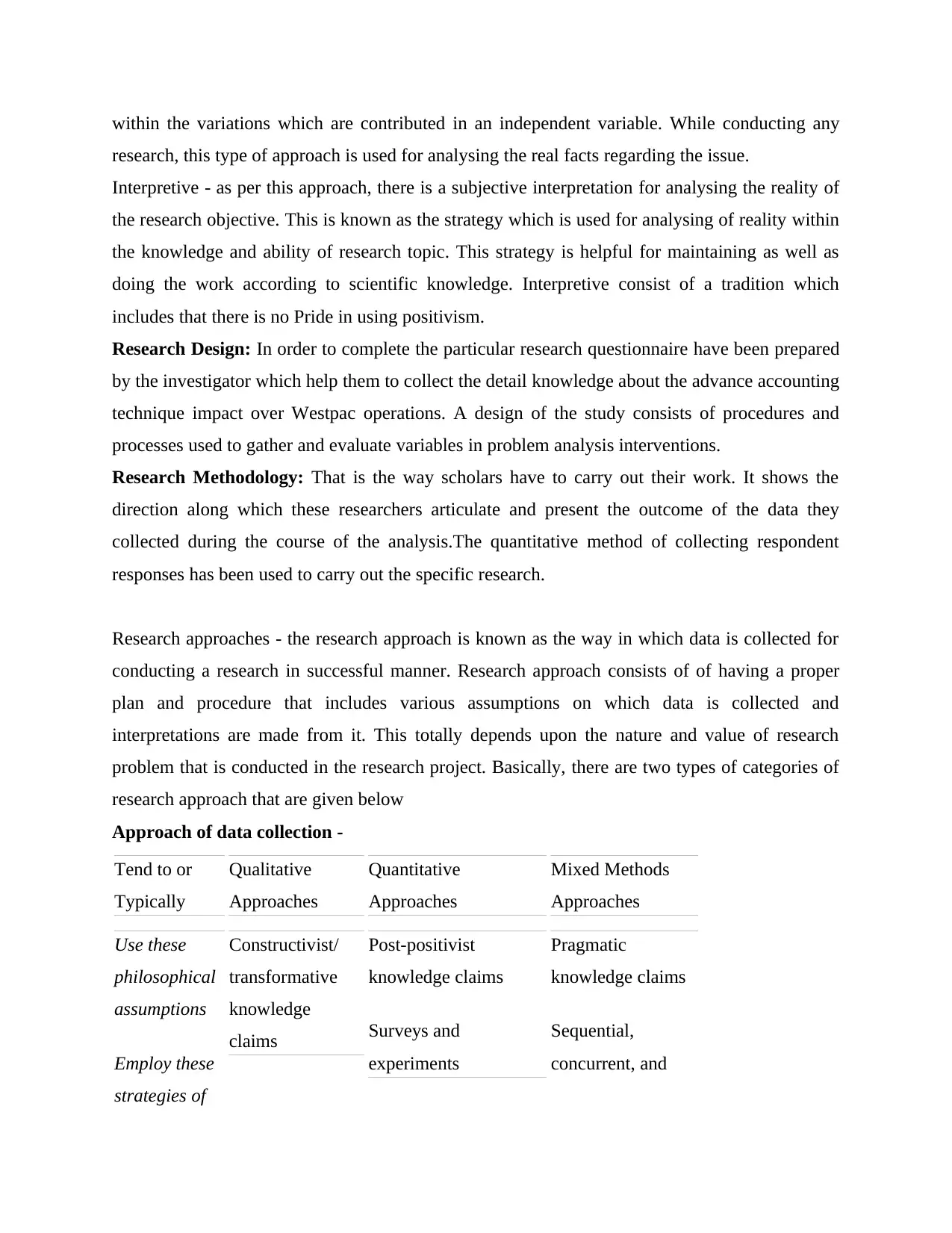
within the variations which are contributed in an independent variable. While conducting any
research, this type of approach is used for analysing the real facts regarding the issue.
Interpretive - as per this approach, there is a subjective interpretation for analysing the reality of
the research objective. This is known as the strategy which is used for analysing of reality within
the knowledge and ability of research topic. This strategy is helpful for maintaining as well as
doing the work according to scientific knowledge. Interpretive consist of a tradition which
includes that there is no Pride in using positivism.
Research Design: In order to complete the particular research questionnaire have been prepared
by the investigator which help them to collect the detail knowledge about the advance accounting
technique impact over Westpac operations. A design of the study consists of procedures and
processes used to gather and evaluate variables in problem analysis interventions.
Research Methodology: That is the way scholars have to carry out their work. It shows the
direction along which these researchers articulate and present the outcome of the data they
collected during the course of the analysis.The quantitative method of collecting respondent
responses has been used to carry out the specific research.
Research approaches - the research approach is known as the way in which data is collected for
conducting a research in successful manner. Research approach consists of of having a proper
plan and procedure that includes various assumptions on which data is collected and
interpretations are made from it. This totally depends upon the nature and value of research
problem that is conducted in the research project. Basically, there are two types of categories of
research approach that are given below
Approach of data collection -
Tend to or
Typically
Qualitative
Approaches
Quantitative
Approaches
Mixed Methods
Approaches
Use these
philosophical
assumptions
Employ these
strategies of
Constructivist/
transformative
knowledge
claims
Post-positivist
knowledge claims
Surveys and
experiments
Pragmatic
knowledge claims
Sequential,
concurrent, and
research, this type of approach is used for analysing the real facts regarding the issue.
Interpretive - as per this approach, there is a subjective interpretation for analysing the reality of
the research objective. This is known as the strategy which is used for analysing of reality within
the knowledge and ability of research topic. This strategy is helpful for maintaining as well as
doing the work according to scientific knowledge. Interpretive consist of a tradition which
includes that there is no Pride in using positivism.
Research Design: In order to complete the particular research questionnaire have been prepared
by the investigator which help them to collect the detail knowledge about the advance accounting
technique impact over Westpac operations. A design of the study consists of procedures and
processes used to gather and evaluate variables in problem analysis interventions.
Research Methodology: That is the way scholars have to carry out their work. It shows the
direction along which these researchers articulate and present the outcome of the data they
collected during the course of the analysis.The quantitative method of collecting respondent
responses has been used to carry out the specific research.
Research approaches - the research approach is known as the way in which data is collected for
conducting a research in successful manner. Research approach consists of of having a proper
plan and procedure that includes various assumptions on which data is collected and
interpretations are made from it. This totally depends upon the nature and value of research
problem that is conducted in the research project. Basically, there are two types of categories of
research approach that are given below
Approach of data collection -
Tend to or
Typically
Qualitative
Approaches
Quantitative
Approaches
Mixed Methods
Approaches
Use these
philosophical
assumptions
Employ these
strategies of
Constructivist/
transformative
knowledge
claims
Post-positivist
knowledge claims
Surveys and
experiments
Pragmatic
knowledge claims
Sequential,
concurrent, and
⊘ This is a preview!⊘
Do you want full access?
Subscribe today to unlock all pages.

Trusted by 1+ million students worldwide
1 out of 15
Related Documents
Your All-in-One AI-Powered Toolkit for Academic Success.
+13062052269
info@desklib.com
Available 24*7 on WhatsApp / Email
![[object Object]](/_next/static/media/star-bottom.7253800d.svg)
Unlock your academic potential
Copyright © 2020–2025 A2Z Services. All Rights Reserved. Developed and managed by ZUCOL.



